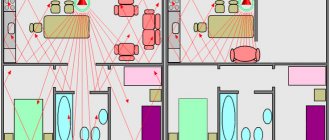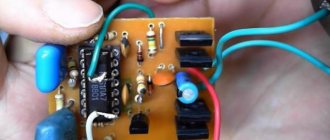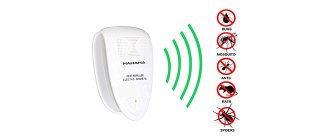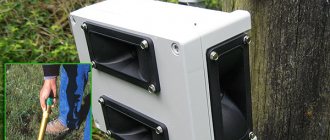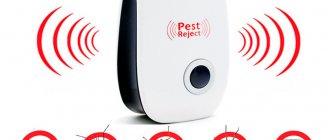Needless to say, all kinds of electronic rodent repellers are at the peak of their popularity today. It’s worth taking an interest in this topic at least once - and then on all sites you will be caught up with advertisements for ultrasonic, electromagnetic and magnetic resonance devices. And if you listen to the advertising, almost every one of them is certainly positioned as the most effective and generates the very sound that repels rats and mice. A sound that (quote from one of the sites) “will make rodents forever forget the way to your house...”
Well, the idea is really tempting: you don’t need to poison rats, you don’t need to take their carcasses with broken bones out of rat traps, you don’t even need to get a cat. To scare away rats from the house, just plug in a small “squeaker” into the outlet - and, it seems, rodents will no longer appear in the room.
However, in reality everything is not so simple. In fact, it turns out that a product that really “squeaks”, that is, its sound is audible to a person, will not be able to scare away either rats or mice. Only ultrasonic repellers are effective against rodents, that is, devices from which the human ear cannot perceive sound (oscillation frequency above 20,000 Hz).
Next, we will look in more detail at what specific sound is suitable for repelling rats, but for now it is only worth noting that even ultrasonic devices are effective in one, and many commercially available devices do not help drive away rodents and have virtually no effect on them at all.
On a note
Sometimes people seriously expect to scare away rats using their mobile phone. The logic here is simple: why spend money on a special device if the sound can be reproduced on a phone or, for example, a tablet? And if you download it from the Internet and play exactly the sound that is unpleasant to rats and mice and that scares them away, then it would seem that the animals should run away from the room in panic. Such sounds have indeed already been recorded and made publicly available.
However, the devil here, as always, is in the details: due to technical limitations, a phone will never replace a good repeller, since the speakers simply will not be able to reproduce ultrasound correctly.
However, it is quite possible to scare away rats from your home. And if you understand well what these animals are generally afraid of and how different devices work, then you can save a lot of time and money on rodent control.
What sounds are rats and mice afraid of?
Generally speaking, both rats and mice are afraid of sounds not only in the ultrasonic range. First of all, they are afraid of quiet sounds - those created by their natural enemies (a creeping cat, the sound of the wings of a bird of prey). Experiments have shown that animals react to them more sharply and quickly than to loud sounds: roar, people's voices, or even the sounds of explosions.
And this is quite understandable - most rats end their lives in the teeth and paws of cats, ferrets, snakes and falcons. These predators do not make any noise while hunting, but try to move as silently as possible.
It has also been experimentally established that rats are frightened by any unfamiliar sounds. Not knowing whether they are a sign of danger or not, the animal will prudently avoid them so as not to take risks until it understands that these noises do not pose any threat. These can be sounds of completely different frequencies and volumes, the main thing is that they have not sounded in this room before and the rats do not know them.
On a note
Therefore, by the way, rats can be scared away a couple of times by loud music or even screaming. But this will not give a long-term effect - the animals quickly get used to the musical preferences of the owners of the house and in the future feel quite comfortable during daily concerts.
Finally, the third and most important type of sounds that scare away rats are the animals’ own signals, with which they notify each other of danger, or which they involuntarily emit in moments of aggression, severe fright, or in their death throes. Such noises are most effective, since animals are afraid of them instinctively and rarely get used to them.
There is another important detail - many sounds from the “rat vocabulary” are inaudible to humans. Rats and mice can hear and produce sounds with frequencies up to 70 kHz, which the human ear cannot perceive at all. Actually, that’s why they are called “ultrasound” (from the Latin ultra - above, above, excessively, that is, they are beyond the range accessible to humans).
It is precisely these ultrasounds that are most convenient to use in the fight against rodents - while creating discomfort for pests, they do not interfere with people at all. Agree, not every person (and even more so when it comes to neighbors) can stand listening to the loud squeak emitted by the device for days on end. If an ultrasound generator is operating in the room, people will not hear it at all, but it will scare away rats. If this is, of course, a good generator...
On a note
Scientists have found that male mice attract females with ultrasonic songs that are as complex as the songs of birds. Perhaps if we could hear such singing, we would appreciate its beauty.
Of course, not all ultrasound scares rodents. Throughout the ultrasonic range there are frequencies that are neutral for them and those that cause discomfort. And the task of generating a sound that actually causes fear in rats, or is simply unpleasant to them, is quite difficult.
It is also useful to read: Poison from rats and mice Goliath and features of the use of this remedy
For example, in experiments, scientists found that rats are afraid of noise in the following frequency ranges:
- 25-28 kHz. This is how a rat screams when it feels pain;
- 32-33 kHz is a danger signal. It is emitted, for example, by a rat that a cat is trying to catch;
- 35-60 kHz - in this range there is a “squeak” with which the animal simply expresses its discomfort.
(Of course, not only frequency is important here, but also signal modulation).
In mice, stress signals also occur in several frequency ranges, with the highest frequency range being 96 kHz.
So, in order to scare away rats and mice, you need to create such sounds in the room from time to time. But here, as always, there are several difficulties...
Using the scents of natural enemies
It's no secret that rodents are afraid of cats, which are considered their main “thunderstorm.” However, this trend is more true for village cats than for pets living in comfortable apartments.
But should you be upset if your purr runs away in fear from one type of mouse, and you can’t rely on his hunting instincts? No, because you can drive out uninvited gray guests using the smell of a cat, or rather its urine. To do this, you can place used cat litter near the holes or soak rags with urine. Inhalation of ammonia vapor leads to a sharp decrease in the number of mouse offspring, causing the population to die out faster.
However, even more than cats, small rodents are afraid of snakes and rats. For the former, they act as natural food, while the latter fight with them for the same food sources and destroy their burrows. Therefore, mice can smell the excrement of their enemies a mile away and avoid them. You can easily become the owner of this “wealth” in any pet store.
Using these methods in an apartment is not very pleasant, but they are quite suitable for dachas, vegetable gardens and non-residential premises.
How to scare away rats using sound?
The main problem with using ultrasound is that it is almost impossible to accurately predict the frequency at which rats will be afraid of it. Moreover, a device that will generate the same sound will most likely not be effective: animals will quickly get used to its signal.
In good repellers, this problem is solved simply: the frequencies in them are constantly changing, and the device periodically makes exactly those sounds that cause discomfort or even fear in rats and mice. Due to the fact that the frequency change occurs in a random mode, the animals cannot get used to them or to the intervals between frightening signals, and therefore quickly stop visiting the room that seems dangerous to them.
The photo below shows as an example the Sititek 2D ultrasonic rodent repeller, for which the following operating mode is stated:
But it’s unlikely to be possible to generate such a sound using improvised means. There are no household devices that create rat-repellent noise in the ultrasonic range, and even with a randomly changing frequency (even high-quality computer speakers are not designed to reproduce ultrasound).
It’s easier to buy good ultrasonic repellers than to try to make them yourself - you just need to be able to choose a really high-quality device. A few words about choosing a repeller are written below.
This is interesting
People still use flayer methods of repelling rodents. For example, it is believed that if a live rat is nailed to the wall of a cowshed, chicken coop or goat shed, then the companions will definitely run away in horror from its dying screams. For the same purpose, someone is trying to burn rats alive indoors. The effectiveness of such methods is generally low: it is unlikely that it will be possible to abuse animals this way every day, and within a couple of days after the death of a tortured animal, its fellow animals will still return to the premises. And the sheer cruelty of such methods makes them unacceptable for use.
Light
Rats are nocturnal animals, and other things being equal, they prefer to be in dark places and go out in search of food at dusk and in the dark. However, they easily and quickly adapt to light, and if they do not encounter any dangers in illuminated places and in bright rooms, they quickly cease to be afraid of light. Often, rats become diurnal and forage in daylight.
This means that although in general rats are afraid of light, it will not be possible to use this as a permanent repellent. If you leave the light on in the room, then after a few days the animals will stop paying attention to it.
On a note
Interestingly, due to the specific nature of their vision, rats do not perceive infrared light. In zoos, this is used to switch nocturnal rodents to daytime mode: during the day a red light is on in the enclosure, and the animals believe that they are in the dark, and at night a regular incandescent lamp is turned on, and the rodents go to sleep. As a result, visitors during the day can observe animals that lead a nocturnal lifestyle.
Choosing an ultrasonic repellent device
The practice of fighters against rats and mice shows that repellers that cost more than 1,000 rubles work reliably. In the case of these devices, the price quite well reflects the level of quality: cheaper than 1000 rubles, they usually sell obvious junk, sometimes only simulating work by flashing LEDs.
Moreover, special tests were carried out on several dozen devices on basement and free-living rats in abandoned enterprises. It turned out that powerful and more or less reliable means that can repel pests are:
- Chiston 2 (its price is approximately 2,200 rubles);
- Chiston 2 PRO (costs about 2,500 rubles);
- Bioguard (4500 rubles);
- TM-315 (costs more than 10,000 rubles);
- WK-0600 (7500 rubles);
- UZU-03 (costs about 3,000 rubles);
- Spectrum (3500 rubles);
- Tornado 800 (popular device, price approximately 3,500 rubles);
- Tsunami-2 (the cheapest on the list, costs just under 2,000 rubles);
- KQ-202 A (about 8,000 rubles).
The photo below shows the Chiston 2 repeller:
And here is Tornado 800:
These devices are more likely to scare away rats from a large apartment or from a medium-sized private house, from a basement or technical room. However, even they sometimes do not give a visible effect.
On a note
You can also scare a rat using an ultrasonic dog shocker. However, you won’t be able to use this product all the time, since it drains the battery too quickly.
Sometimes devices from the Elektrokot, Grad, and Typhoon brands work, and sometimes they don’t help. They look effective in reviews on YouTube when the device is turned on directly in a mouse cage, but in a large house the power of the repeller may not be enough.
It is also useful to read: How to poison rats and mice to quickly get rid of their presence in the house
Preventive actions
Once bats have been expelled, it is important to prevent them from returning. For this, preventive measures are necessary. Namely:
- completely clear the areas of excrement, debris and dirt left by bats and thoroughly disinfect these areas;
- tightly seal all cracks and holes in the attic, under the roof and in the basement;
- plaster the attic and repair the roof of the house;
- If the holes cannot be sealed, cover them with fiberglass or mesh;
- hang balls made of foil; in the wind they create noise that will scare away mice;
- Provide basements and attics with lighting.
Can you use a computer or phone to repel rats?
A logical thought may come to the mind of a modern active user of electronic gadgets: should we try to scare away rats with a sound recorded on a phone or computer?
In fact, this idea is not new, but it has already failed several times. First of all, because the speakers of most devices “for people” are not designed to reproduce ultrasound. And not only the speakers, but also the electronic part itself (the amplifier) is not designed for such frequencies.
In addition, the power of the speakers of mobile devices leaves much to be desired. The “ultrasonic” squeak from them will practically not be heard at the end of a medium-sized room.
However, the sounds supposedly repelling rats from the house have already been recorded on mp3. Just for fun, you can download them and try to play them on your phone:
Another version of the scaring sound (20,000 Hz)
Just remember that it is ultrasound that scares rats, which the human ear cannot perceive. This means that if a clearly audible squeak is recorded in an mp3, then there is practically no hope for it.
On a note
For those who like to experiment, today an application for the phone (smartphone) has even been developed, which is called “Rat Repeller”. This program not only generates sounds, but also changes their frequencies.
Ultrasound in the life of rodents
Let's start with the fact that ultrasound refers to sound vibrations with a frequency above 20,000 Hz, that is, above the hearing threshold of the average person. Humans cannot hear ultrasounds, but many other animals perceive them quite normally.
Only a very few, especially sensitive people, are able to hear sound with a frequency just above 20 kHz. Such high-pitched sounds are perceived as a very thin, barely audible squeak.
The gray rat can perceive sounds with a frequency of up to 40 kHz, the house mouse - up to 100 kHz. That is, what is absolutely inaudible for humans is important sound information for these animals.
What is useful to know about ultrasound:
- The nature of ultrasound is no different from the nature of other sounds, which means it has the same characteristics: volume (power), directionality, ability to be reflected and absorbed. A small ultrasonic repeller, powered by a small AA battery, a priori cannot generate powerful ultrasonic radiation, and loud advertising statements about the amazing effectiveness of such “babies” in areas of several hundred square meters can only cause a smile;
- Any sounds, including ultrasound, can convey different information to an animal - neutral, unpleasant, frightening (a message about danger). That is, not every ultrasound will scare a rat, just as people do not attach significance to every sound;
- Rats, mice and other rodents actively use ultrasound for communication - for example, they use it to transmit signals of help or danger to each other.
What else are rats afraid of and how can you scare them away?
Of course, rats are afraid of more than just sounds. They, for example, also avoid many odors, and they also try to use this to get rid of annoying rodents.
For example, rats are known to be repelled by:
- Technical liquids with strong odors - gasoline, kerosene, turpentine, karbofos, vinegar, denatured alcohol;
- Aromas of certain herbs (for example, black root);
- Strong odors of perfumes, including essential oils.
However, there is a nuance - pests quickly get used to these products. For example, if today turpentine or camphor oil repels rats in the house, then after about a week the animals will be absolutely indifferent to it.
The main disadvantage of these products is that their smell in the house is clearly felt by humans. To prevent rats from daring to enter living quarters, there should be such a strong smell (in fact, stink) of gasoline or black root that people themselves will not be able to live in such conditions. That is why such means are rarely used: a sane person will not want to sacrifice comfort.
On a note
A cat is a good, but not always effective, home protector from rats. If she really is a rat catcher, then you will know about the presence of rodents only by the corpses that the pet will carry to you for praise. If the rats understand that the cat will not catch them (in fact, there are a lot of such cats), then they will boldly visit the home, no matter how strongly it smells of cat litter.
When to start expulsion
Considering that bats are listed in the Red Book, killing them is prohibited. The only way to get rid of bats at the dacha is to “smoke out” the animals from their favorite places. But it is necessary to start such activities only at a certain time.
The following periods will be an exception:
- Feeding offspring . Usually mice mate in the fall, and 1-2 cubs appear in the spring. During the feeding period, the female does not leave the habitat, and the small animals cannot fly out of the hole on their own.
- Winter . It is also an unfavorable period for the expulsion of bats. In winter, these animals hibernate; if they are awakened and driven out, they may die.
Expert opinion
Mityuk Stefania Bogdanovna
The best time to expel bats is the beginning of the autumn period.
Before developing a plan to combat animals, determine their habitats. This is not difficult to do - using the droppings that mice leave in large quantities. Animal excrement is dark brown in color with shiny inclusions (these are the remains of the shells of large beetles). Chiropteran droppings cannot be confused with mice or rats. Be sure to mark all the passages through which the animals enter their habitat. Keep in mind that nimble mice can get into holes even 1.5 cm wide.
What definitely won't repel rats?
Finally, it is almost certain that you will not be able to repel rats with the many cheap Chinese repellers that are actively sold on the Internet. In fact, these tools do nothing; often their task is simply to blink a light so that the user thinks that the device is working. They are bought in the hope of saving money and with the understanding that if the device does not help, then they will not mind the money spent. Actually, this is exactly what happens.
It is useful to pay attention to the operation of the repeller you are purchasing: if a device declared as ultrasonic clearly beeps, it means that it has nothing to do with ultrasound. Therefore, it is unlikely to drive rats out of the house.
The so-called magnetic resonance and electromagnetic devices, which supposedly create a field in the apartment’s electrical network that repels insects and rodents, are also useless. There is no theoretical explanation for this effect, but in practice people find that rats and mice do not pay attention to such devices at all.
On a note
Another sure sign of an ineffective repeller is a statement from the manufacturer or seller that the device is supposedly universal and repels all parasites and pests in the house in general - not only rats, but also bedbugs, cockroaches, woodlice, flies...
Various folk repellents almost always turn out to be useless. For example:
- Elder;
- Broken glass scattered near rat passages;
- Black beans;
- Red pepper, also scattered near rat shelters;
- Ash;
- Singed fur;
- Burnt rubber...
At best, these drugs can cause some alertness in rats, but not for long. The animals quickly get used to it and do not leave the house.
If you have personal experience in repelling rodents from your home (by any means), be sure to share the information by leaving a review at the bottom of this page.
Interesting video: ultrasound on Android
Important Tips
Summer residents who are learning how to get rid of bats in their dachas sometimes make serious mistakes when fighting bats.
Failure to comply with safety precautions can lead to unpleasant consequences:
Do not pick up bats with your bare hands
Chiropterans are not aggressive, but when frightened, they can bite a person. The sharp teeth of animals leave wounds that take a long time to heal and can become infected. To remove the animal from its perch, use a fishing landing net with a mesh of small cells.
If a bat bites you, wash the wound with running water and laundry soap for 10-15 minutes. Then treat the bite site with iodine, apply a bandage and go to the medical center.
You cannot leave traces of animals after they have been expelled.
Remains of excrement, flakes of skin and fur can become a source of infection and a breeding ground for parasites. Be sure to thoroughly sanitize these areas.
The procedure for expelling bats from their favorite territories cannot be called quick and easy. Stubborn animals are extremely reluctant to leave their usual habitats. Therefore, arm yourself with patience and perseverance. And the proper use of tips that tell you how to get rid of bats in your country house will guarantee a good and long-lasting result.
Is ultrasound safe for humans and pets?
For humans, ultrasound of not very high power (up to about 10 W) is relatively safe. Only very powerful repellers can have an effect, although the person does not understand that this is happening. For example, under the influence of ultrasound and prolonged use of the device in residential premises, people sometimes develop headaches. Therefore, ultrasonic repellers are not recommended for long-term use in residential areas. Moreover, they cannot be used in bedrooms.
Many pets can hear ultrasound well, and it can negatively affect their condition. Domestic rodents - rats, mice, hamsters - react most acutely to the signals of the device. Dogs and cats can also hear the device's signals well, and in some cases these sounds can put them in a state of stress.
Some Chinese battery-powered ultrasonic repellers are described in advertising as being completely safe for any pet. And this is really close to the truth - due to their insignificant power, they do not have a noticeable effect on either domestic animals or rodents.
What do special studies say about the effectiveness of ultrasound against rats?
The results of several practical experiments on “wild” basement rats are known. The essence of the experiments was as follows:
- In one of the rooms of an abandoned building infested with rats, rat traps were installed with bait, but with the brackets removed. These rat traps did not kill the animals or even catch them, but made it possible to record the fact that a rat approached the bait. The rat trap worked, which means the animal was definitely approaching it;
- First, the number of rat traps triggered in the absence of the device was recorded;
- Then the test repeller was turned on in the room for the whole night, and the next morning the number of activated rat traps was assessed.
The more effective the repeller was, the fewer rat traps were triggered when the device was operating compared to the period without the repeller (the rats ran around the room less).
In such experiments, many devices were tested, and based on the results, it became clear that there are both quite effective professional products on the market and outright fakes that do not repel rats at all. When some devices were operating, the rats did not approach the baits at all, while near other devices they calmly fed and went about their “own business.”
In laboratory studies, it was found that rats, constantly exposed to ultrasound and unable to hide from the signals, were in a state of continuous stress, refused to eat and died after some time.
Here are just some of the fairly well-proven ultrasonic rodent repellers:
“To be honest, I was afraid to turn on the ultrasound in the chicken coop. I even thought about ordering a special safe trap to catch the rats. But then I took a risk. And it’s normal, the chickens didn’t seem to hear anything at all. And the rats disappeared, I haven’t seen them for a month now...”




